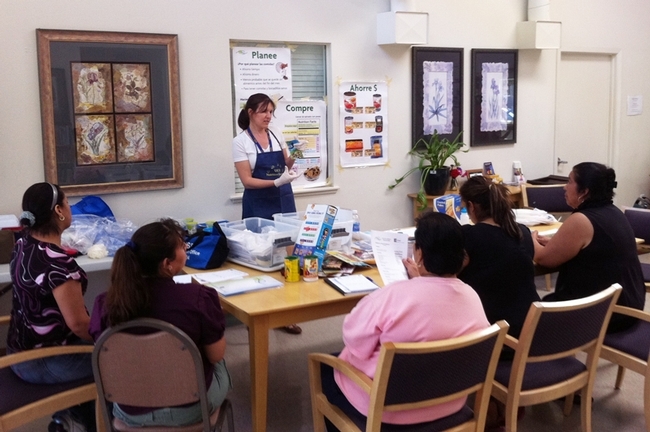
The curriculum, called “Plan, Shop, Save & Cook,” was adapted for UC CalFresh nutrition education by UC ANR Cooperative Extension academics. The program, offered in 31 California counties, is proven to help recipients of Supplemental Nutrition Assistance Program (SNAP, formerly food stamps) eat healthier and avoid running out of food by the end of the month. In California, SNAP is known as CalFresh.
The proof stems from an analysis of pre- and post-program surveys of nearly 4,000 adults who completed the four-part “Plan, Shop, Save & Cook” course. Researchers concluded that food assistance combined with nutrition and resource management education reduces food insecurity in low-income families. The results were published in the Journal of Nutrition Education and Behavior.
Plan, Shop, Save & Cook was implemented in California in 2011. From 2011 to 2013, educators in 15 counties asked participants to fill out a brief survey before and one month after completing the four-week course. The survey aimed to determine whether they were using key strategies shared in the classes, including planning meals, using a shopping list, comparing prices, reading labels, thinking about healthy choices and eating varied meals.
“We confirmed that our program helps educate and motivate participants, leading to healthier eating,” said Lucia Kaiser, UC ANR Cooperative Extension specialist based in the Department of Nutrition at UC Davis. “Increasing resource management skills – the ability shop smart and read food labels – is important to reducing food insecurity.”
Kaiser, the study's lead author, also pointed out that receiving the supplemental food benefits is a critical factor in addressing food insecurity.
“Families need SNAP and access to healthy foods in their neighborhoods,” Kaiser said. “The people in our study who were receiving food assistance were eating the best. It's really important to help eligible people get enrolled and receive food assistance.”
In the United States, 14.5 percent of households are “food insecure” – they don't have access to enough food for an active, healthy life for all household members. Among those below the income eligibility cutoff for SNAP, the percentage of food insecure households is considerably higher. Food insecurity has been associated with inadequate nutrient intake, poor mental and physical health, substandard economic performance, increased risk of chronic disease, poor psychological cognitive function and obesity.
“It may seem counter-intuitive, but research has shown that body mass index is greater in households with lower socio-economic status,” Kaiser said. “Food insecurity and obesity may coexist because the least expensive foods are often lowest in nutrients and highest in calories, and in low income areas, healthy food is not always available.”
A higher level of food assistance benefits may allow families to purchase more fruits, vegetables, whole grain products and lean dairy and protein foods. Effective education also contributes to these healthy eating habits. The Plan, Shop, Save & Cook classes are offered to small groups of adults in community settings and include skill-building activities, such as writing a menu and comparing it to dietary recommendations. Participants taste low-cost healthy foods and receive recipes to try at home.
For more information about Plan, Shop, Save & Shop contact a county UC ANR Cooperative Extension office.
An initiative to maintain and enhance healthy families and communities is part of the UC Division of Agriculture and Natural Resources Strategic Vision 2025.